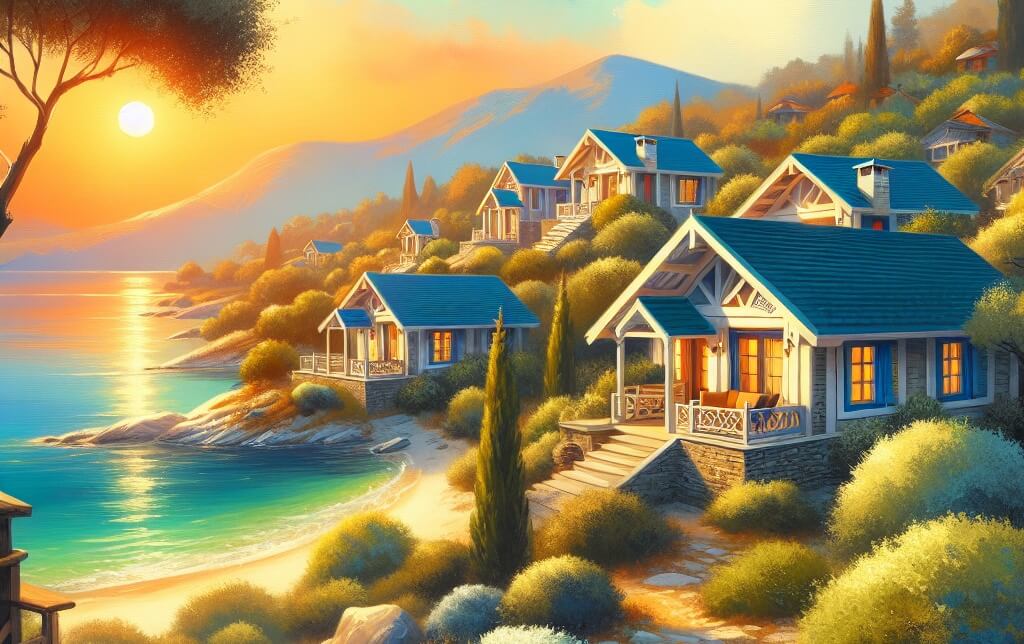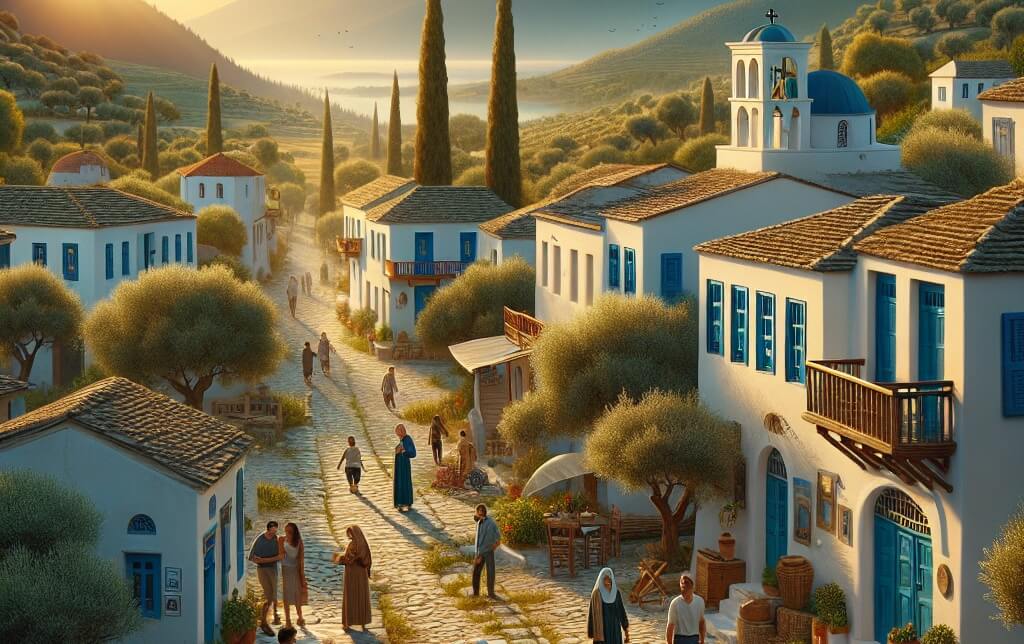
Explore Stunning White Buildings in Santorini, Greece
Santorini, Greece is renowned for its stunning white buildings that adorn the cliffs overlooking the azure waters of the Aegean Sea. These iconic structures, with their distinctive white-washed walls and blue-domed roofs, create a picturesque and enchanting landscape that has captivated visitors from around the world. The traditional architecture of Santorini reflects the island's rich history and unique charm, providing a glimpse into the island's past while offering a serene and idyllic setting for exploration and relaxation. Whether strolling through the narrow cobblestone streets of Oia or admiring the panoramic views from Fira, the white buildings of Santorini exude a timeless beauty that is truly unforgettable.
I. Introduction
Santorini, a picturesque island located in Greece, is renowned for its iconic white buildings that adorn the cliffside overlooking the deep blue waters of the Aegean Sea. The unique architecture of Santorini's white buildings, characterized by their whitewashed walls and blue domes, has become synonymous with the island's charm and beauty. This architectural style not only reflects the island's rich history and cultural heritage but also serves a practical purpose by helping to keep the buildings cool in the Mediterranean heat. The striking contrast of the white buildings against the azure sea and sky has made Santorini a popular destination for tourists seeking a postcard-perfect setting for their vacation.
II. Santorini's White Buildings
Santorini's iconic white buildings are a defining feature of the island's architectural landscape. The striking contrast of the white buildings against the deep blue waters of the Aegean Sea creates a picturesque and timeless scene that has captivated visitors for generations. The traditional whitewashed buildings are not merely a design choice, but a practical response to the island's hot climate. The white exterior helps to reflect the sun's rays and keep the interiors cool during the scorching summer months. Additionally, the white buildings contribute to the overall aesthetic harmony of the island, creating a sense of unity and cohesion in the architectural style of Santorini.
III. Cycladic Architecture
III. Cycladic Architecture is a distinctive style characterized by its white-washed buildings with blue domes, commonly found on the Greek island of Santorini. This architectural tradition is rooted in the historical and geographical context of the Cyclades islands, where materials such as volcanic rock and lime plaster were used to construct simple yet elegant structures. The stark white facades not only reflect the abundant sunlight, keeping the buildings cool during the hot summer months, but also create a striking contrast against the deep blue of the Aegean Sea. The use of minimalistic design elements and curved shapes in Cycladic architecture harmoniously blend with the natural landscape, creating a timeless aesthetic that has captivated visitors and inspired architects around the world.
IV. Historical Context
The historical context of Santorini, Greece, with its iconic white buildings, is deeply rooted in the island's architectural traditions and geographical significance. The distinctive whitewashed buildings that dot the island are a reflection of the island's history and culture, dating back to the ancient Minoan civilization. The use of whitewash was initially employed as a practical solution to combat the intense heat and sunlight of the Mediterranean climate, with the white color helping to reflect sunlight and keep the buildings cool. Over time, this practice evolved into a cultural tradition, with the white buildings becoming synonymous with the picturesque beauty of Santorini. Additionally, the unique architecture of Santorini's white buildings is also influenced by the island's volcanic landscape, as many of the structures are built into the cliffs and caves created by past volcanic eruptions. This blend of practicality, tradition, and natural landscape has contributed to the enduring charm and allure of Santorini's white buildings, making them an integral part of the island's historical identity.
V. Reasons for White Color
The predominant use of white color in the buildings of Santorini, Greece can be attributed to several reasons. Firstly, the white buildings help to reflect the strong sunlight and heat of the Mediterranean climate, keeping the interiors cooler and more comfortable for residents and visitors. Additionally, the white color creates a striking contrast against the deep blue sea and sky, enhancing the picturesque and iconic aesthetic of the island. Furthermore, the tradition of whitewashing buildings in Santorini dates back centuries, serving both practical and cultural purposes. Overall, the choice of white color in the architecture of Santorini not only serves functional purposes but also contributes to the unique charm and beauty of the island.
VI. Impact of Weather Conditions
The impact of weather conditions on the white buildings of Santorini, Greece, is significant and plays a crucial role in their preservation and aesthetic appeal. The island's unique climate, characterized by hot summers and mild winters, contributes to the distinctive white color of the buildings, which are often constructed using local volcanic stone and lime wash. However, the harsh sunlight and strong winds can also pose challenges, causing the buildings to fade and deteriorate over time. Additionally, the occasional rain showers and humidity can lead to moisture damage and mold growth, necessitating regular maintenance and restoration efforts to ensure the longevity of these iconic structures. Overall, the weather conditions in Santorini have both positive and negative impacts on the white buildings, shaping their appearance and requiring careful attention to protect their beauty and historical significance.
VII. Caldera Offer and Panoramic Views
The Caldera Offer in Santorini, Greece presents a unique opportunity to experience unparalleled panoramic views amidst the iconic white buildings that adorn the island. This exclusive offer not only allows guests to immerse themselves in the breathtaking beauty of the Caldera cliffs but also provides a serene setting to appreciate the charm and allure of Santorini. The juxtaposition of the azure waters against the pristine white structures creates a picturesque scene that is truly unrivaled. Visitors can indulge in the tranquility and majesty of the surroundings, making the Caldera Offer a must-have experience for those seeking a luxurious and unforgettable stay in Santorini.
VIII. Blue Accents
In the context of the task focusing on Santorini, Greece's white buildings, the addition of blue accents, as indicated by 'VIII. Blue Accents,' serves to enhance the island's iconic aesthetic. The contrast between the pristine white facades and the vivid blue details creates a striking visual appeal that is synonymous with the unique charm of Santorini. The blue accents not only complement the surrounding natural elements, such as the azure waters of the Aegean Sea and the clear blue skies, but also pay homage to the traditional blue-domed churches that dot the island's landscape. Overall, the incorporation of blue accents in the architecture of Santorini's white buildings adds a touch of vibrancy and character to the already picturesque setting, further solidifying its status as a renowned destination for travelers seeking beauty and tranquility.
IX. Domed Churches and Blue Domes
In the context of Santorini, Greece, known for its iconic white buildings set against the backdrop of the Aegean Sea, the presence of domed churches and blue domes holds significant cultural and aesthetic importance. The domed churches, with their distinctive architectural style, not only serve as places of worship but also contribute to the overall charm and character of the island. The blue domes, in particular, stand out against the white buildings, creating a striking contrast that has become synonymous with the picturesque landscapes of Santorini. These domed structures not only add to the allure of the island but also serve as a testament to its rich history and architectural heritage.
X. Whitewash Homes and Cave Houses
Whitewashing homes and cave houses has been a longstanding tradition in Santorini, Greece, contributing to the iconic white buildings that have become synonymous with the island. The practice of whitewashing serves multiple purposes beyond aesthetics, including protecting the buildings from the intense Mediterranean sun and helping to keep interiors cool during the hot summer months. Additionally, the white color reflects sunlight, creating a visually striking contrast against the blue skies and sea, enhancing the overall beauty of the island's landscape. This architectural style has not only become a defining feature of Santorini but also a symbol of its unique charm and allure, drawing visitors from around the world to experience its picturesque beauty firsthand.
XI. Tourism and Luxury Hotels
Tourism in Santorini, Greece, is closely intertwined with the presence of luxury hotels on the island. The iconic white buildings that dot the landscape of Santorini have become synonymous with luxury travel, attracting visitors from around the world seeking a high-end vacation experience. These luxury hotels offer unparalleled views of the stunning Aegean Sea, impeccable service, and lavish amenities to cater to the discerning tastes of their guests. The combination of the unique architectural charm of Santorini and the luxurious accommodations provided by these hotels has solidified the island's reputation as a premier destination for luxury travelers seeking a truly indulgent experience.
XII. Conclusion
In conclusion, the iconic white buildings of Santorini, Greece stand as a testament to the island's unique charm and beauty. The striking contrast of the white-washed buildings against the deep blue waters of the Aegean Sea creates a picturesque and unforgettable scene. The architectural style of the buildings, with their curved edges and domed roofs, reflects the traditional Cycladic design that has been preserved and maintained throughout the centuries. Visitors to Santorini are not only captivated by the stunning views and romantic sunsets, but also by the rich history and culture that permeate the island. The white buildings of Santorini serve as a symbol of the island's enduring allure and continue to attract travelers from around the world seeking a glimpse of this idyllic paradise.









